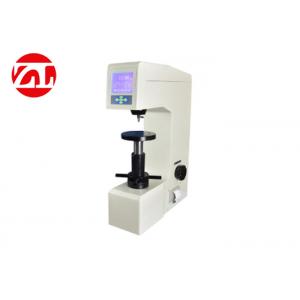Laboratory HRS-150 Large Screen Digital Rockwell Hardness Tester
Laboratory HRS-150 Large Screen Digital Rockwell Hardness Tester adopts a novel large-screen LCD display, and the operation panel
adopts a menu structure. Its main functions are:
1 Selection of Rockwell hardness scale,
2 Choice of plastic Rockwell scales,
3 The hardness conversion between various hardnesses,
4 Hardness test result printout,
5 With automatic storage function and RS-232 super terminal
settings, the machine has good reliability, the working process is
more user-friendly, the operation is simple, and the test results
are directly displayed digitally.
Scope of application:
Quenched steel, quenched and tempered, annealed steel, chilled
castings, malleable castings, carbide steel, aluminum alloy,
copper, bearing steel, etc.
Technical parameters:
| Initial Testing Force | 10Kg(98.07N) |
| All Testing Force | 60Kg(588N),100Kg(980N),150Kg(1471N) |
| Indication of Hardness Value | Digital Display |
| Duration Time | 0~60s |
| Max Height of Specimen | 200mm |
| Max Width of Specimen | 165mm |
| Dim ension(DxWxH) | 520X215X700(mm)
|
| Net Weight | 65Kg
|
| Power Supply | AC220V±5%,50~60Hz/(or AC110V±5%) |
| Standard Accessories | Standard Rockwell hardness block |
Diamond Rockwell Hardness Indenter,Diameter1.5875mm Ball Indenter Tasting Table(big,medium,"V") 3 pcs Weight(a,b,c) Power cord |
| Optional Accessories | Diameter3.175mm,Steel Ball Indenter |
People also like ask
1. How do you perform a hardness test?
A hardness test is typically performed by pressing a specifically
dimensioned and loaded object (indenter) into the surface of the
material you are testing. The hardness is determined by measuring
the depth of indenter penetration or by measuring the size of the
impression left by an indenter.
2. How do I find my Rockwell hardness number?
The Rockwell hardness number is calculated from the depth of
permanent deformation of the indenter into the sample, i.e. the
difference in indenter position before and after application of the
major load. The minor and major loads can be applied using dead
weights or springs.
3. How ofen should a durometer be calibrated?
one year
Unless otherwise requested the calibration interval on your
durometer will be one year. Several factors should be taken into
consideration such as: the required accuracy vs. the instruments
accuracy, the impact an out of tolerance reading will have on the
process, and the performance history.
4. How do you calibrate a digital hardness tester?
PROCEDURE Take out the force gauge to be calibrated and hold
vertically up. Adjust the zero on the force gauge. Standard Weights
are then applied to the hook of force gauge and measure the tension
of the spring on the force gauge. When 1 kg of standard weight is
applied, scale on the force gauge should also show 1 kg tension
produced from the initial point where the pointer is adjusted.
Adjust the zero on the force gauge again. Follow the same procedure
for other weights. The test to be carried out for 1.0 kg, 2.0 kg,
5.0 kg, 10.0 kg, 20.0 kg & 30.0 kg standard weights.
Machine Certificate:
Business license Fame Certificates Wall
Factory environment area:
Company outdoor view Reception
Sales Team and Technicial Team:
Exhibition:


